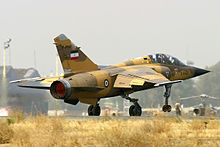Islamic Republic of Iran Air Force
[citation needed] This "new" Iranian air force largely inherited the equipment and structure of the former IIAF, even losing most of its leading officers in the course of post-revolutionary chaos, as well as due to the prosecution of those considered as loyal to the Shah, pro-U.S. or elsewhere by the new government in Tehran.
Due to strained relations with the West, Iran had to procure new equipment from Brazil, the Soviet Union and the People's Republic of China.
Many aircraft belonging to the Iraqi Air Force took refuge in Iran during the Persian Gulf War in 1991 and many were put into service with the IRIAF or taken apart for spare parts.
The sudden Iraqi air strikes against eight major Iranian airbases and four other military installations, launched on the afternoon of 22 September 1980, came as a complete surprise and caused a shock in the IRIAF.
Saddam Hussein and the Iraqi military were dealt a heavy blow when Iranian Air Force vulnerabilities failed to materialize.
Although the readiness rates of the IRIAF significantly increased in the following months, its overall role and influence declined, as the clerical government prioritized resources for the Islamic Revolutionary Guard Corps (IRGC) militias and simultaneously attempted to develop a separate air arm for this service.
Simultaneously, the IRIAF had to learn how to maintain and keep operational its large fleet of U.S.-built aircraft and helicopters without outside help, due to American sanctions.
Starting from 1984 and 1985, the IRIAF found itself confronted by an ever-better organized and equipped opponent, as the Iraqi Air force—reinforced by deliveries of advanced fighter-bombers from France and the Soviet Union—launched numerous offensives against Iranian air bases, military bases, industrial infrastructures, power plants, oil-export hubs, and population centers.
To defend against an increasing number of Iraqi air strikes, the IRIAF leaned heavily on its large fleet of Grumman F-14 Tomcat interceptor fighters.
[citation needed] Confronted with the fact that it could not obtain replacements for equipment lost in what became a war of attrition against Iraq, the IRIAF remained defense-orientated for the rest of the conflict, conserving its surviving assets as a "force in being".
As a result of this war, the IRIAF developed proven tactics and skillful battle tested pilots, thus becoming one of the most experienced air arms in the region.
The most notable Iranian fighter pilots were Fereydoun Ali Mazandarani, Fazlollah Javidnia, Jalil Zandi and Shahram Rostami.
Despite threats of response, Iraq was not able to retaliate due to its own fight against Kurdish separatist guerrillas and the Western-imposed no-fly zones that crippled and limited its air force's operations.
[4][5] In 2007, Iraq asked Iran to return some of the scores of Iraqi fighter planes that flew there ahead of the Gulf War in 1991.
[9] In 2006, after Iranian media published a series of reports suggesting that Venezuela was interested in selling its 21 F-16 Fighting Falcons to Iran,[10] a Hugo Chavez adviser confirmed to the Associated Press that "Venezuela's military is considering selling its fleet of U.S.-made F-16 fighter jets to another country, possibly Iran, in response to a U.S. ban on arms sales to President Hugo Chávez's government".
Subsequently, Russia has begun to supply Iran with more advanced weapon systems, namely the Yakovlev Yak-130 jet trainer, which had its first two examples delivered in September 2023.
As of 2013 the Iranian authorities also changed the command structure (tactical air bases, military installations, civil airports) and this former status is not in effect any longer.
However, less tension in the current (2015) international situation led to a decrease of the sanctions, and the Iranian government is now capable again in ordering a new fleet of civilian aircraft replacing the aged types.
In 2007, Iraq asked Iran to return some of the scores of Iraqi fighter planes that flew there ahead of the Gulf War in 1991.
However, the poor state of Iran's finances and the threat of American sanctions on those trading with the country made it unlikely for Tehran to pass large orders for military equipment.
[39] In November 2023, deputy defense minister Mehdi Farahi said that plans had been finalized for the Iranian armed forces to receive Sukhoi Su-35s, Yakovlev Yak-130s and Mil Mi-28s.
Its ability to control the national airspace, however, remains limited—mainly due to the rugged terrain and lack of airborne early warning assets.










